Hello language learners, today I would want to talk about learning English! The 11-year-old Hyderabad company called Code and Pixels – Digital Teacher developed a software called the Digital “English Language Lab” that makes learning the English language easy to understand. By Following the CEFR (Common European Framework of Reference) guidelines we have developed the language lab product with the assistance of Cambridge instructors. In addition to the basics of grammar for practice, our lab software includes 440 learning modules covering phonetics, listening, speaking, reading, writing, vocabulary building, soft skills, and life skills. They cover each topic a student of English would like to learn.
We developed the product with an understanding of the Indian educational system and the mindset of students. Grammar basic concepts include a wide range of subjects, including verbs, pronouns, and nouns. Every level offers practice exercises and presents fresh ideas.
Features of our Language Lab software system include:
- Menu (Help, full-screen mode, and menu options)
- History (Simple access to view open subjects, such as grammar rules.)
- Bookmarking (To explore readily available topics, such as grammar rules.)
- A user-friendly interface. (Pause, play, rewind, or fast-forward) and many more features are mentioned below.
Language Lab Software: A Brief Introduction
The interactive English language lab is useful for both students and teachers. It focuses on the important aspect that is, learners may use the software on their own, without continuous instructor monitoring. The Digital Teacher English Language Lab has improved the quality of English language learning in schools.
We, Digital Teacher created the product considering keeping notice of the mindset of Indian schools and students. Now let’s look into the basic rules of grammar. We have added something to the product that is similar to a brush-up. Just to give you an example, the infographic below shows the software’s visualisation, which includes the basic concepts of grammar.
 Basics of Grammar Activity on English Language Lab Software
Basics of Grammar Activity on English Language Lab Software
Level 1 includes the definitions of nouns, pronouns, and verbs. Additionally, level 2 contains verb tenses with subject agreements, such as past and future tenses. punctuation. So these are the useful openings. (Basic Level)
For any language, whether technical or non-technical, it is very important to have strong basics. Right, without basics, without a strong foundation, you cannot have a strong building. So, let’s begin with improving your grammar: What are the basic English grammar rules? Let’s take a closer look at sentences and parts of speech and how they tie into the rules of grammar.
Digital Teacher English Language Lab Software: After every activity, the questions and answers are set up with interesting tasks to help students and English lab learners understand the topic clearly!
For example, after learning about the basics of grammar, students can test their knowledge with 10 interactive questions. If students don’t grasp them all right away, don’t worry. We provide a thorough report that includes the result, the right answers, and even explanations for the ones you didn’t get. You can always go back and get better!
Please watch the “English Language Lab Software demo Video” below to understand how our English lab activities take place successfully.
Digital Teacher English Language Lab Software FULL-DEMO Video
Monitoring and Tracking Student Activity: In the English Lab Why?
One of the best things about Language Lab software is that it allows teachers to keep an eye on their students’ activities through its tracking features. The opportunity to track progress is an important aspect of digital language laboratories that significantly improve language learners’ performance.
But, we won’t recommend much because, as you can see, the majority of the learners in this language lab are not very interested in it. Giving them the software at their fingertips. Right, in additional monitoring student computer screen is not a feature of any language lab. Yes. If you want, there are other, free software which are available in the market. Alright, additionally software for many computer management and monitoring systems is available for free or payment.
Features of Blended Learning in Digital Language Lab Software
The following features, which provide several alternatives, are also included in the Language Lab: Menu-help, bookmark, history, and close. Let’s explore them in more detail!
- History: Keep track of what you’re learning by going over the topics and length of time you have studied.
- Bookmark: Save important information in bits for later usage. (This feature helps support different learning styles. Students may make customized study destinations, return challenging sections without having to start over from the beginning and keep important passages for later review.)
- Full Screen: Make the most of your use and attentiveness.
- Menu: Quickly access different features and activities. (User-friendly Navigation)
- Unlimited Learning: No time limit on exploring the software. It is available to you at all times. To get maximum benefit out of the learning experience, students/ learners may go back and review courses, do tasks again, and use bookmarks as well.
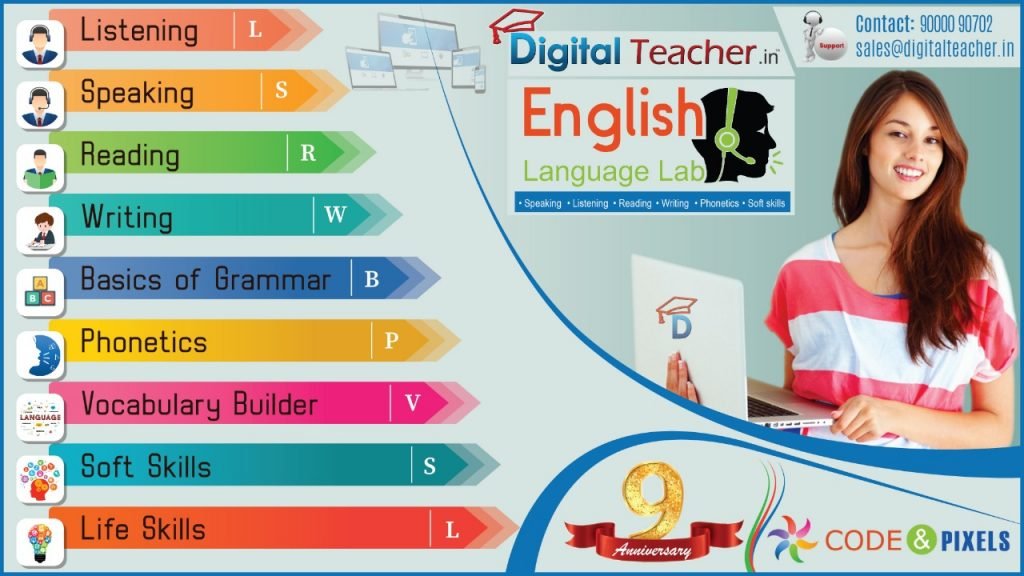
Complete Overview of L-S-R-W Skills: Speaking, Listening, Reading, and Writing
Six levels are available here: Level A is A1, A2 (basic), Level B is B1, B2 (intermediate), and Level C is C1, C2 (mastery).
Let’s explore all of the writing, speaking, listening, and reading. There are six levels in the listening section: A1, A2, B1, B2, C1, C2. There are several activities available at each level, such as answering questions, listening to audio snippets, and taking external evaluations. Students have many opportunities to practice and enhance their listening skills through the software.
Top 6 Levels of Listening Skills: Beginner to Expert
- Level A1: Activities at level A1 focus on understanding the appearance of letters, sounds, images, actions, and simple words. These include identifying objects in images, associating sounds with letters, and comprehending basic commands.
- Level A2: We have announcements, general tales, inspiring stories, moral stories, and evaluations in Level A2.
- Level-B1 & B2: The content and level increase as we go on to the intermediate levels B1 and B2. Activities such as radio talk, form filling, historical events, jumbled sentences, summarizing a narrative, describing an activity, and assessments are all included in B2.
- Level C1: Describe food, True/False questions, Speaking Practice, Vocabulary development, Conversational situations, Picture cues, and other difficult tasks are included in this advanced level.
- Level C2: weather report, debate, interview, board, the autobiography of famous personalities, and the importance of a day. In listening, we cover lectures, speeches, presentations, and assessments. and other challenging tasks are included in this advanced C2 level.
Levels of Speaking Skills: Basic to Advanced (What are They?)
Speaking activities are divided into multiple topics, including vocabulary, science, arithmetic, practice words, pair work, image questions, and discussions. Pupils get access to audio files, voice recordings, and pronunciation guides.
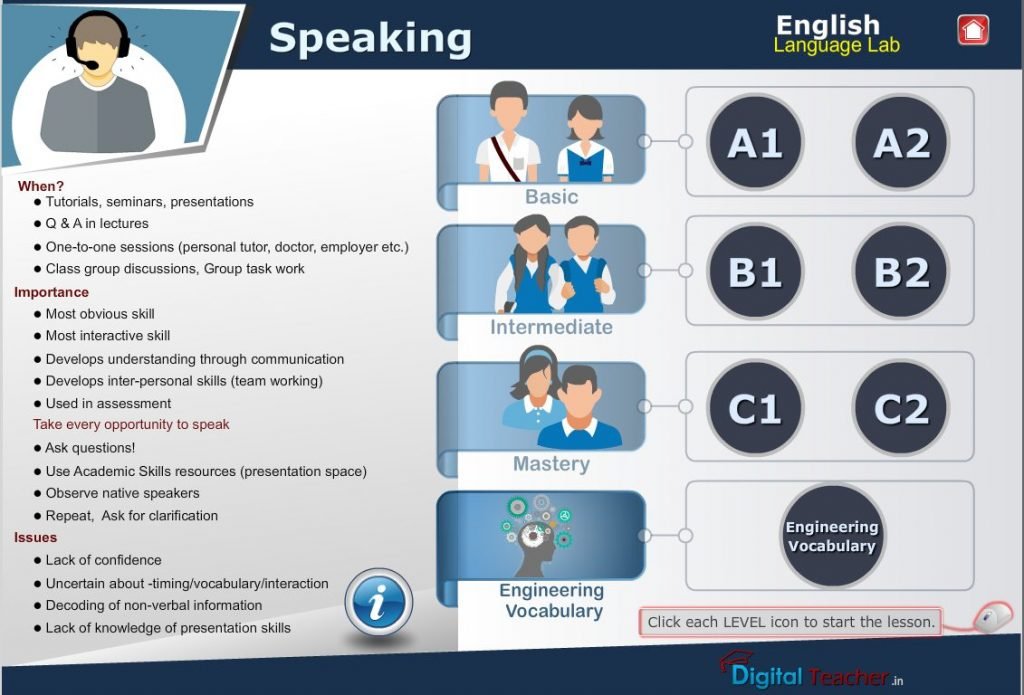 English Language Lab Speaking Skills
English Language Lab Speaking Skills
Exploring Levels and Types of Speaking Skills:
Speaking has been divided into two different types: speaking production and speaking interaction. Speaking exercises include word practice, vocabulary building, science, arithmetic, pair work, preparing to speak, questioning on pictures, and discussions at home, at school, and in other places. Let me explain one of the activities, which is word practising words.
Speaking Skills Activity:
In this Speaking activity, you can see how the words are spoken by clicking the audio play button. It is possible to record, check and download is offered. The voice may be downloaded and saved to a chosen file by clicking the “download” button. The pronunciation is assessed by the system, which offers comments on speed and behaviour under stress.
For example, You can hear that the word “stay,” for instance, was a little sluggish in the middle. Instead of providing a percentage, the software offers speech input that is in line with Indian language usage.
Please watch the “speaking skills activity” video below if you still have questions regarding the speaking activity. If you need additional explanation, please don’t hesitate to reach us at www.englishlab.co.in
Speaking Skills Activity, English language lab – Digital Teacher
Remember that in the process of learning speaking skills, what happens here is directly we are not going to give them the speaking part. First, we are going to train them on the basic concepts. Then, we’ll go with the phonetics because, students need to understand exactly how and where before moving on to the product, let’s start with the phonetics.
Phonetics:
- Phonetics here develops from monosyllabic to hexasyllabic. We have the monosyllabic language with pictures, which is to say, language with words. As we all know, mono means that a word is available or does not have any surroundings.
- Using an audio script, introduce yourself to others.
- Activity: Playing out a dialogue between a teacher and a student
Around 2,500+ words in phonetics, as I pointed out, which are monosyllabic to hexasyllabic. Alright. The remaining portion looks like the vocabulary builder. Picture representation is provided for stages one through eight of the vocabulary builder.
For an example, look at it:
- My brother, father, mother, and grandpa make up my family.
- The head is one of the body components.
- TV and sofa in the living room.
Vocabulary Builder:
Therefore, the vocabulary builder in this English language lab of Digital Teachers has more than 3,000+ words. We have life skills as well as soft skills in the Additional Content. This is for upper-level college students’ classes on presentation, communication, group discussion, and life skills. These are helpful in the classroom, where students learn about self-introduction, the value of relationships, good touch and bad touch, overcoming fear, and how to make learning enjoyable. A few months ago, the software providers of the Digital Teacher English Lab added on. And the reading section comes next.
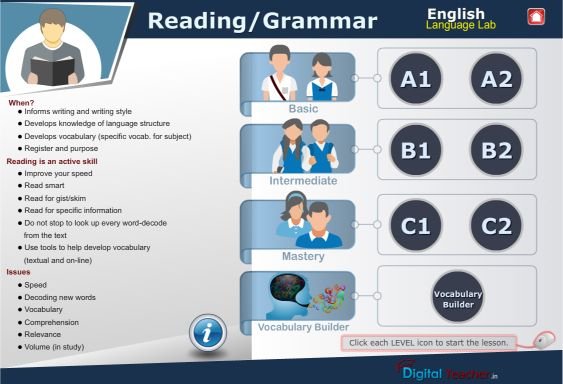
Reading Skills: A1-Basic to C2-Mastery
We provide a range of reading levels with a wide range of topics in the section. A1 and A2, for instance, concentrate on letters, paid letters, images, activities, settings, narratives, and evaluations. Students can choose from a selection of tasks in these external assessments.
To make studying enjoyable We addressed this in the reading part. A couple more futures existed.
Language Lab: Features of Reading Activities:
- Interactive tasks to enhance comprehension.
- There are many levels of complexity in the reading activities.
- Students can read and respond to questions to demonstrate comprehension.
- Story Activities: includes listening to short stories.
- Answering questions to figure out knowledge.
- Examination and Statements
- External Evaluations
- Academic success on an individual basis is not the focus.
- focuses on general competence at every stage.
- Reports on Growth
- Performance information was gathered to assess course performance.
- Not employed to track the performance or activities of specific students.
Remember that the above features’ purpose is to give you a clear, understandable explanation that highlights the opportunities for growth at various reading skill levels.
We have yet to discuss the writing part. I would now want to go into more detail regarding the levels, topics, and objectives of the writing activities in the section below.
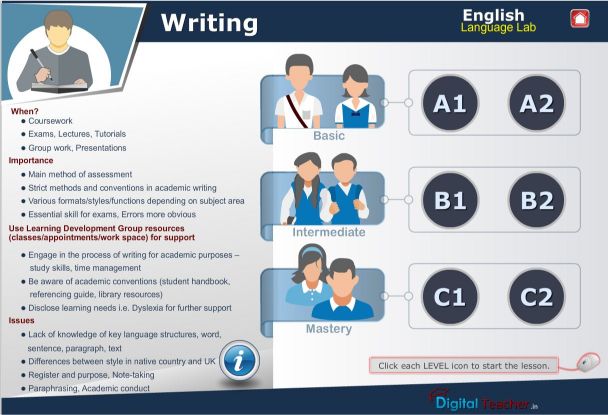
Writing Skills Activity: In our English Language Lab Software
The writing section includes a variety of exercises, such as word and letter problems, picture-based assignments, and paragraph writing. Users pick up skills in understanding data and information summarizing via charts. This comprehensive approach to writing enables students for practical tasks including producing essays and analytical reports.
Writing in the A and B levels: in these levels, the writing component moves from simple tasks like composing sentences and letters to creating paragraphs. The learning path is demonstrated with particular examples such as guided paragraph writing and picture interpretation.
Writing Paragraphs: The explanation of a paragraph as a collection of well-structured sentences centred around a single idea, along with the method for creating paragraphs utilizing cues and examples, gives students insightful direction.
Writing C1 & C2 level Activities: Higher levels, such as C, call for advanced thinking skills, such as the ability to read charts and graphs. At the C level, an illustration of a bar graph reading task complete with reference material and follow-up questions shows the degree of intellectual participation.
The English Language Lab proves to be a complete language learning resource. The platform accommodates learners of various skill levels, from basic grammar to excellent writing skills. With its detailed courses, interactive features, and emphasis on practical applications, it is a priceless resource for educational institutions, and individuals seeking to improve their English Language.




.jpg)
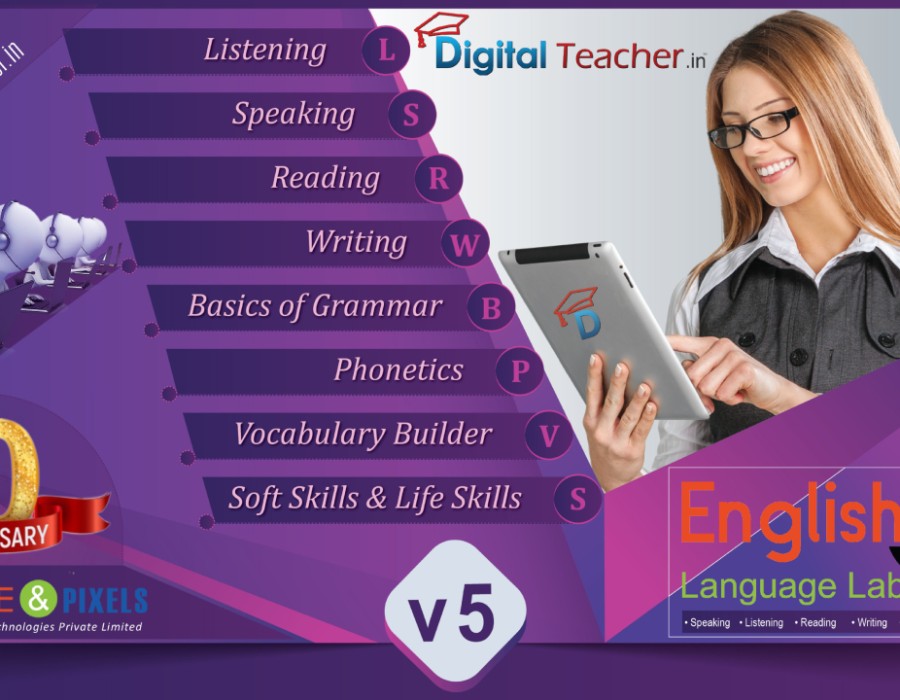
Comments